Kunstmuseum Liechtenstein
The Kunstmuseum Liechtenstein (English: Liechtenstein Museum of Fine Arts) is the state museum of modern and contemporary art in Vaduz, Liechtenstein.[1] The building by the Swiss architects Meinrad Morger, Heinrich Degelo and Christian Kerez was completed in November 2000. The museum collection of international modern and contemporary art is also the national art collection of the Principality of Liechtenstein. In 2015, the new Hilti Art Foundation exhibition building was added to the Kunstmuseum. This important private collection from Liechtenstein comprises outstanding works of classical modernism and contemporary art.
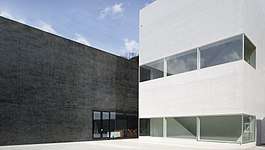
 | |
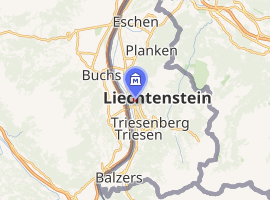
| |
| Established | 12 November 2000 |
|---|---|
| Location | Vaduz, Liechtenstein |
| Director | Friedemann Malsch |
| Owner | Prince of Liechtenstein Foundation |
| Website | http://www.kunstmuseum.li |
History
In 1967, the State of Liechtenstein received a gift of ten paintings which resulted in the foundation of the State Art Collection of Liechtenstein the following year. The first curator of the collection was Dr Georg Malin, a Liechtenstein artist, historian and art historian. He soon expanded the collection to include international modern and contemporary art.
The building of the Kunstmuseum Liechtenstein how it presents itself today was realized with the support of a group of private donors. Together with the government of Liechtenstein and the City of Vaduz, they planned and implemented the construction of the museum.
In August 2000, the building was officially donated to the Principality of Liechtenstein as a millennium gift. The government established a public foundation to operate the museum. The Kunstmuseum Liechtenstein was formally opened on 12 November 2000.
Mr Friedemann Malsch has been the director of the Kunstmuseum Liechtenstein since 1996.
Architecture
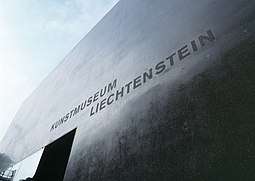
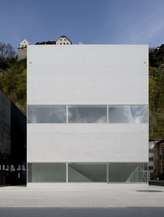
The Kunstmuseum Liechtenstein was built by the Swiss architects Meinrad Morger and Heinrich Degelo, along with Christian Kerez. Together they have created a museum building of great structural complexity and discreet simplicity. The closed form is a "black box" of tinted concrete and black basalt stone. River pebbles embedded in the building's exterior provide a subtle coloration, forming a link to the landscape of the Rhine Valley. The hand-carved surface of the facade invites touching, and reflects the surroundings. Long rows of windows open the black cube to both inside and outside.
Inside the black box is a perfect White Cube. The building is clearly structured with maximum space devoted to art. The visible exterior of the building corresponds almost exactly to the public exhibition spaces. There are six exhibition rooms arranged around two diametrically opposed staircases. The ground plan, reminiscent of a windmill's sails, enables diagonal views through the whole building. These exhibition rooms offer art the largest possible freedom through their clarity and precision.
- Hilti Art Foundation
With the new exhibition spaces, the Hilti Art Foundation continues and intensifies its long-standing collaboration with the Kunstmuseum Liechtenstein. A visible expression of this connection is the design of the new building in the form of a cube. Conceived by the Basel-based company Morger Partner Architekten, the building forms a unified presence with the Kunstmuseum Liechtenstein directly adjacent. The cubic form, as well as the construction and material of the facade, reflect the common bonds of the two institutions under the aegis of a single museum. As a further sign of togetherness, access to the new exhibition spaces is provided through a shared entrance with Kunstmuseum Liechtenstein.
Collection
The collection is the heart of the Kunstmuseum Liechtenstein, from which all other areas and activities develop. The collection is the driving force behind the exhibition programme and provides the impetus for our broad and active education programme. It also represents the larger part of the state's art collection and as such is an important and integral part of the public image of Liechtenstein.
The collection of international modern and contemporary art covers the period from the 19th century to the present; the acquisition policy focuses on 20th and 21st-century works, especially sculptures and installations. Special attention has been given to the selection of independent artistic positions. Furthermore, the artworks are not only of the highest quality but also engage in a stimulating dialogue with other works.
The acquisition policy intentionally avoids limitations of geography, style, epoch or specific media; instead, it pursues themes of particular significance in modern and contemporary art. Abstract and minimal art, conceptual art and Arte Povera encounter anthropological approaches of the kind found in symbolism, futurism and surrealism, or in the individual mythologies of Joseph Beuys and in other aspects of Arte Povera.
In 2007, the Kunstmuseum Liechtenstein together with the Kunstmuseum St. Gallen and the Museum of Modern Art, Frankfurt acquired the collection of Cologne-based gallerist Rolf Ricke that includes works by Richard Artschwager, Bill Bollinger, Donald Judd, Gary Kuehn, Fabian Marcaccio, Steven Parrino, David Reed, Richard Serra, Keith Sonnier or Jessica Stockholder. Although the collection is divided between three, in terms of possessive right, it remains intact as the partner museums will have equal access to the complete stocks.
Exhibitions
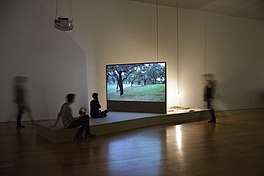
Past exhibitions include Gary Kuehn, Otto Freundlich, Gottfried Honegger, Leiko Ikemura,[2] Rita McBride, Paul Klee, Jochen Gerz, André Thomkins, František Kupka, Andy Warhol, Fabian Marcaccio, Alighiero Boetti, Fred Sandback, Georg Malin, Sean Scully, Matts Leiderstam, Ferdinand Nigg, Monika Sosnowska, Joseph Beuys, Thomas Schütte, Kazimir Malevich, Martin Frommelt, Matti Braun, Christian Boltanski, Gotthard Graubner, Bill Bollinger, Bojan Šarčević, Günter Fruhtrunk, Kimsooja, Ilja Taschaschnik, Latifa Echakhch, Saâdan Afif, Gary Kuehn, Alexander Rodtschenko, Charlotte Moth, Georg Malin, Bertrand Lavier or Anna Kolodzieska.
Since the May 2015 opening of its exhibition building adjoining Kunstmuseum Liechtenstein, the Hilti Art Foundation has presented a changing selection of paintings, sculptures and objects from the holdings in its art collection, covering the period from classical modernism to the present. The current selection includes works by Gauguin, Picasso, Léger, Beckmann, Kirchner, Klee, Kandinsky, Dubuffet, Giacometti, Graubner, Knoebel, Morellet, Sonnier, Scully and others. The exhibition is organized into themes and chronological eras corresponding to the building's division into three levels.
Extension – Hilti Art Foundation
Since May 2015, Kunstmuseum Liechtenstein is expanded by the Hilti Art Foundation's new exhibition building and enriched by a first-class and internationally renowned private art collection. With the new exhibition spaces, the Hilti Art Foundation continues and intensifies its long-standing collaboration with the Kunstmuseum Liechtenstein. A visible expression of this connection is the design of the new building in the form of a cube. Conceived by the Basel-based company Morger Partner Architekten, the building forms a unified presence with the Kunstmuseum Liechtenstein directly adjacent. The cubic form, as well as the construction and material of the facade, reflect the common bonds of the two institutions under the aegis of a single museum. As a further sign of togetherness, access to the new exhibition spaces is provided through a shared entrance with Kunstmuseum Liechtenstein.
References
- Bianchini, Riccardo (8 February 2015). "Kunstmuseum Liechtenstein". www.inexhibit.com. InExhibit. Retrieved 18 June 2020.
- ""Leiko Ikemura; Ozean – ein Projekt", solo – Kunstmuseum Liechtenstein, Vaduz, Liechtenstein – 08.03.2002-12.05.2002". Archive.org. 2002. Archived from the original on 4 March 2016. Retrieved 4 March 2016.
External links
| Wikimedia Commons has media related to Kunstmuseum Liechtenstein. |